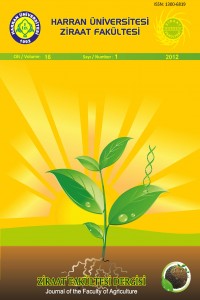Abstract
Stickiness in cotton fibers is one of the most important problems of textile industry. Stickiness occurs in cotton fibers due to physiological sugars produced by the plants themselves, entomological sugars produced by feeding insects like aphid and cotton whitefly, the climatically conditions in which cotton is grown, the agricultural methods used, the incorrect harvesting, ginning and storage procedures. Sticky cotton fibers makes difficult the spinning mills, contaminating all mechanical equipment involved in the process from fiber to yarn which
includes opening, carding, drawing, roving, and spinning operations. In addition to these, yarn quality including fiber strength, ginning outturn, uniformity and yarn dyeing characteristics are
negatively affected.
Keywords
References
- Brushwood, D.E. and H.H. Perkins, Jr., 1994. Characterization of sugars from honeydew cottons. p. 1408-1411. In Proc. Beltwide Cotton Conf., San Diego, CA. 5-8 Jan, 1994 Natl. Cotton Counc. Am., Memphis, TN. and normal
- Brushwood, D., 1998. Carbohydrates on silverleaf whitefly contaminated cottons. Textile Chemist and Colorist 30(2):33-35.
- Chun, D.T.W., and Brushwood, D., 1998. High Moisture Storage Effects on Cotton Stickiness September 1998. 68: 642-648 Journal
- Gençer, O., Görmüş, Ö., 1991a. Pamuk Liflerinde Görülen Yapışkanlık Nedenleri. Tekstil maraton dergisi, Ağustos 1991. Sayfa: 18-21.
- Gençer, O., Görmüş, Ö., 1991b. Tarım Sistemi Yönünden Türkiye’de Pamuk Tarımı ve Yapışkanlık Sorunu. Tekstil maraton dergisi, Kasım-Aralık 1991. Sayfa: 29-37.
- Gutknecht, J., J. Fournier and R. Frydrych., 1986. Influence de la teneur en eau et de la temperature de l'air sur les tests du collage des cottons a la minicarde de laboratoire. Cotton et Fibres Tropicales. 41(3): 179-190.
- Hague, S.S., Gannaway, J.R, Boman, R.K., 2008. Combining ability of upland cotton, Gossypium associated with sticky fiber. Eupthytica (2008) 164:75-79 L., with traits
- Hequet, E., D. Ethridge, B. Cole and B. Wyatt., 2000. How cotton stickiness measurements relate to spinning efficiency. p. EngineerFiber Conference. 17-19 April 2000. Cotton Inc., Cary, NC. 13thAnnu. System
- Hendrix, D.L., and K.K. Peelen., 1987. Artifacts in the analyses of plant tissues for soluble 27:710-715. Crop Science
- Hendrix, D.L., Y.A. Wei, and J.E. Leggett., 1992. composition is determined by both the honeydew sugar Gelişmesine, Bitki Araştırmalar (Basılmamış
- Miller, W.B, Pertalla, E, Ellis, D.R, Perkins, H.H., individual insect honeydew carbohydrates on cotton lint. Textile Res J 64:344–350
- Oğlakçı, M., 2009. Lif Teknolojisi. KSÜ.
- Ziraat Fakültesi Tarla Bitkileri Bölümü. Ders Notları.
- Özgür, A. F., Şekeroğlu, E., Gençer, O., Göçmen, H., Yelin D., İşler, N., 1988. Önemli Pamuk Zararlılarının Pamuk Çeşitlerine ve Bitki Fenolojisine Bağlı Olarak Araştırılması. Doğa Türk Tarım ve Ormancılık Dergisi, 12: 48-74.
- Tarczynski, M. C., D. N. Byrne, and W. B. Miller., 1992. High performance liquid chromatography analysis of carbohydrates of cotton-phloem sap and of honeydew produced by Bemisia tabaci feeding on cotton. Plant Physiology 1992. 98:753–756.
- Watson, M.D., 2000. An overview of cotton stickiness. p. 63. In Proc. Int. Cotton Conf, Bremen, Germany. 1-4 March 2000. Faserinstitut, Bremen, Germany.
Abstract
Pamuklu tekstil endüstrisinin en önemli sorunları arasında yer alan pamuk liflerinde görülen yapışkanlık, pamuk bitkisince oluşturulan fizyolojik şekerlerden, pamuk yaprak biti (afid) ve beyaz sinek gibi pamuk zararlılarının oluşturduğu entomolojik şekerlerden, bitkinin içinde yetiştirildiği iklim koşullarından, uygulanan tarım tekniklerinden, hasat ve çırçırlama hataları nedenleriyle pamuk liflerinde oluşmaktadır. Yapışkan pamuklar çırçırda role, testere ve silindirleri kirleterek veya bulaştırarak; tekstil fabrikalarında, liflerin iplik oluşma aşamalarında makinelere dolanarak fabrika randımanını azaltmak suretiyle sorun oluşturmakta ve bunun yanında yapışkanlık özelliği olan liflerden elde edile
Keywords
References
- Brushwood, D.E. and H.H. Perkins, Jr., 1994. Characterization of sugars from honeydew cottons. p. 1408-1411. In Proc. Beltwide Cotton Conf., San Diego, CA. 5-8 Jan, 1994 Natl. Cotton Counc. Am., Memphis, TN. and normal
- Brushwood, D., 1998. Carbohydrates on silverleaf whitefly contaminated cottons. Textile Chemist and Colorist 30(2):33-35.
- Chun, D.T.W., and Brushwood, D., 1998. High Moisture Storage Effects on Cotton Stickiness September 1998. 68: 642-648 Journal
- Gençer, O., Görmüş, Ö., 1991a. Pamuk Liflerinde Görülen Yapışkanlık Nedenleri. Tekstil maraton dergisi, Ağustos 1991. Sayfa: 18-21.
- Gençer, O., Görmüş, Ö., 1991b. Tarım Sistemi Yönünden Türkiye’de Pamuk Tarımı ve Yapışkanlık Sorunu. Tekstil maraton dergisi, Kasım-Aralık 1991. Sayfa: 29-37.
- Gutknecht, J., J. Fournier and R. Frydrych., 1986. Influence de la teneur en eau et de la temperature de l'air sur les tests du collage des cottons a la minicarde de laboratoire. Cotton et Fibres Tropicales. 41(3): 179-190.
- Hague, S.S., Gannaway, J.R, Boman, R.K., 2008. Combining ability of upland cotton, Gossypium associated with sticky fiber. Eupthytica (2008) 164:75-79 L., with traits
- Hequet, E., D. Ethridge, B. Cole and B. Wyatt., 2000. How cotton stickiness measurements relate to spinning efficiency. p. EngineerFiber Conference. 17-19 April 2000. Cotton Inc., Cary, NC. 13thAnnu. System
- Hendrix, D.L., and K.K. Peelen., 1987. Artifacts in the analyses of plant tissues for soluble 27:710-715. Crop Science
- Hendrix, D.L., Y.A. Wei, and J.E. Leggett., 1992. composition is determined by both the honeydew sugar Gelişmesine, Bitki Araştırmalar (Basılmamış
- Miller, W.B, Pertalla, E, Ellis, D.R, Perkins, H.H., individual insect honeydew carbohydrates on cotton lint. Textile Res J 64:344–350
- Oğlakçı, M., 2009. Lif Teknolojisi. KSÜ.
- Ziraat Fakültesi Tarla Bitkileri Bölümü. Ders Notları.
- Özgür, A. F., Şekeroğlu, E., Gençer, O., Göçmen, H., Yelin D., İşler, N., 1988. Önemli Pamuk Zararlılarının Pamuk Çeşitlerine ve Bitki Fenolojisine Bağlı Olarak Araştırılması. Doğa Türk Tarım ve Ormancılık Dergisi, 12: 48-74.
- Tarczynski, M. C., D. N. Byrne, and W. B. Miller., 1992. High performance liquid chromatography analysis of carbohydrates of cotton-phloem sap and of honeydew produced by Bemisia tabaci feeding on cotton. Plant Physiology 1992. 98:753–756.
- Watson, M.D., 2000. An overview of cotton stickiness. p. 63. In Proc. Int. Cotton Conf, Bremen, Germany. 1-4 March 2000. Faserinstitut, Bremen, Germany.
Details
| Primary Language | Turkish |
|---|---|
| Subjects | Food Engineering |
| Journal Section | Derleme Makaleleri |
| Authors | |
| Publication Date | February 20, 2014 |
| Submission Date | February 20, 2014 |
| Published in Issue | Year 2012 Volume: 16 Issue: 1 |
Indexing and Abstracting


